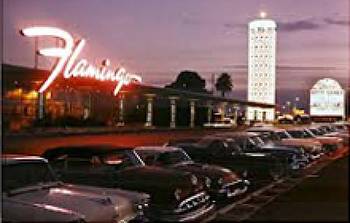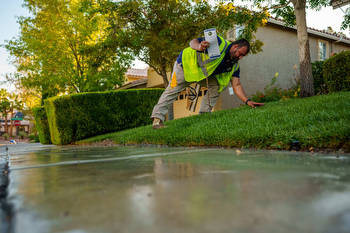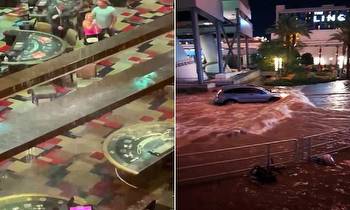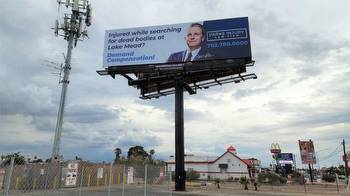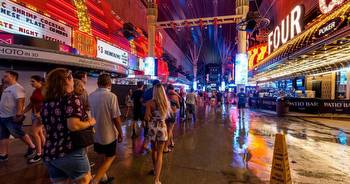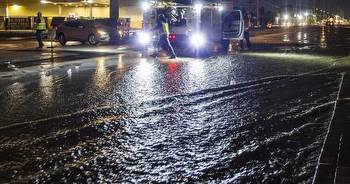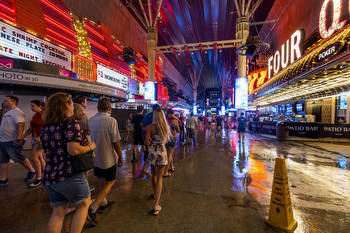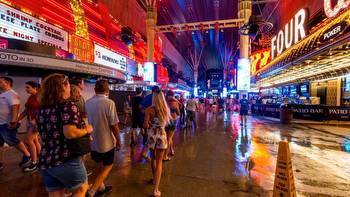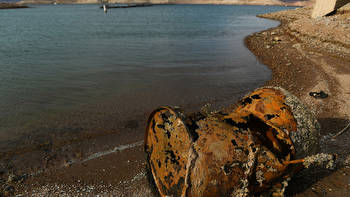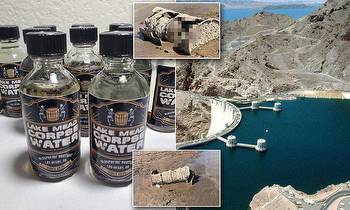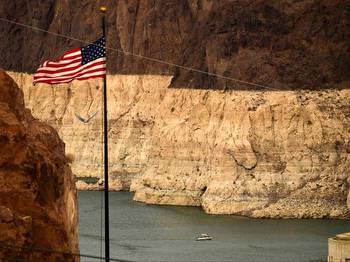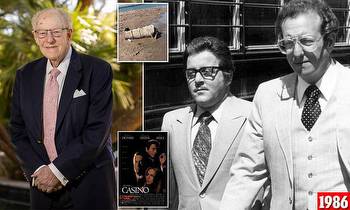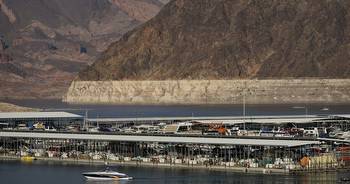Bodies Pulled From Parched Lake Mead Stir Wise-Guy Ghosts of Las Vegas
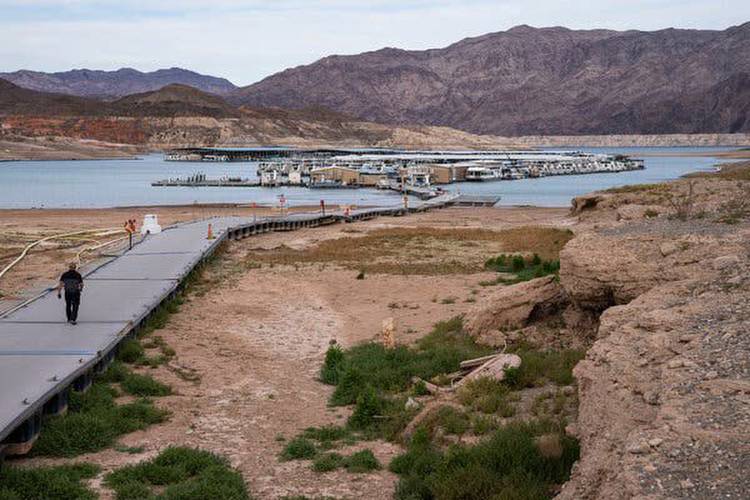
LAS VEGAS — It’s the mob guy who went missing after skimming from the Stardust casino. No, it’s the lake resort manager hunted down by the Chicago Outfit. Could it be the work of a biker gang muscling in on Mafia turf? Or maybe someone just fell off a boat after one too many.
Ever since the bodies started turning up this month in Lake Mead — the first in a barrel, the next half-buried in sand, both exposed by plunging water levels — theories in Las Vegas are flourishing about who they are, how they wound up in the country’s largest man-made reservoir, and what might surface next.
Lynette Melvin found the second body with her sister while paddle boarding. At first they thought they had stumbled onto bones of a bighorn sheep. “It wasn’t until I saw the jawbone with a silver filling that I was like, ‘Whoa, this is human,’ and started to freak out,” Ms. Melvin, 30, said.
The discovery of human remains is always a source of tragedy and potential pain for loved ones — especially when they show signs of a violent end. But in Las Vegas, a town where the seedy underbelly is part of the draw, macabre fascination and amateur sleuthing have quickly followed.
As Ms. Melvin put it: “There’s a whole lot of mystery around them.”
The somber findings come amid the Southwest’s driest two decades in , as drought-starved bodies of water yield one surprise after another.
At Elephant Butte Reservoir in New Mexico, a bachelor party stumbled across a fossilized mastodon skull that is millions of years old. In Utah last year, the receding waters of Lake Powell revealed a car that had plunged 600 feet off a cliff, killing the driver. And as Lake Powell dries up, archaeologists are getting a chance to study newly emerged Indigenous dwellings.
In Las Vegas, the obsession with the Lake Mead remains combines anxiety about the city’s dwindling water supply with the fascination over how mobsters shaped the Mojave Desert outpost into a glittering gambling haven, where pleasure-seekers float down lazy rivers and frolic in colossal pools amid the parched landscape.
Now just 30 percent full, Lake Mead has already fallen to its lowest level since it was filled during the Great Depression, raising fears in places such as Los Angeles, Phoenix and Tucson, Ariz., that also draw water from the reservoir below the Hoover Dam.
Federal authorities announced this month that they would delay releases from the Colorado River into Lake Mead, about 30 miles east of Las Vegas, dwindling it even more.
Jennifer Byrnes, a forensic anthropologist who consults with the coroner’s office in Clark County, which contains Las Vegas, said warming temperatures could reshape her profession. Long-term drought and other changes to the landscape make more grim discoveries possible, and require planning for mass casualty events like deadly heat waves, storms and wildfires.
“Climate change is directly going to affect our field in the coming years,” said Dr. Byrnes, who is also an assistant professor at the University of Nevada, Las Vegas.
In some instances, that means help putting down old cases. After a pickup truck with a female body inside was found in a receding lake in Texas in 2014, officials used dental records to identify a woman who had been missing since 1979.
Still, Dr. Byrnes said, human remains found in places like Lake Mead can be especially challenging. The reservoir is so large that its currents can circulate a body far from where it drowned or was dumped, and cause it to break apart. A body in a container like a barrel, she said, could decompose faster than one exposed to water. And scavengers like water bugs, crabs, fish and birds can complicate efforts to determine identities and causes of death.
None of that has stopped amateur sleuths from poring over clues in Las Vegas’s hottest new cold cases. So far, police investigators have said they do not expect foul play in connection with the body found by the paddle boarders.
But detectives with the Las Vegas Metropolitan Police Department said the victim in the barrel appeared to have died from a gunshot wound, likely in the mid-1970s or early 1980s based on clothing and footwear.
At the time, even as local authorities sought to downplay the influence of organized crime syndicates, mobsters from Midwest cities like Chicago, Milwaukee and Kansas City, Mo., wielded immense clout around Las Vegas. Today, the Mafia’s role in Las Vegas is considered insignificant, but nostalgia for the era of made men has emerged as a big moneymaker.
For a price of $119.95, visitors can take a “mob tour” that features sites where a car bombing and other underworld activities took place. At the Mob Museum downtown, tourists with beers in hand take in exhibitions describing the city’s blood-splattered past.
“This is the town that denied having any connections to the mob,” said John L. Smith, 62, a prominent author and columnist whose family has been in Nevada since the 1880s. “Now it’s a town that puts it on billboards.”
As the museum makes clear, barrels were not unheard-of among the Mafia’s body-disposal methods. In 1976, John Roselli, a crime figure with Las Vegas ties, was found floating dead in one in Biscayne Bay outside Miami. And Mr. Smith said in a column in The Nevada Independent that the discovery in Lake Mead also evoked memories of a cold case involving Johnny Pappas, a Chicagoan who went missing in Las Vegas in 1976.
Pappas, whose underworld associations were noted when he disappeared, managed a resort on Lake Mead backed by a Teamsters pension fund, and had been involved in Democratic politics. “Back then, Las Vegas was a much smaller town where half the people were connected, or wanted you to think they were connected” to the mob, Mr. Smith said.
Other theories about the bodies also abound. David Kohlmeier, a retired police officer who is now a podcaster and social media personality, is offering a $5,000 reward to divers who find other remains in Lake Mead. The areas where the two bodies were found, he said, could have been dumping grounds connected to other crimes. “I think this was gang-related in some way, but that could mean it was a motorcycle gang,” Mr. Kohlmeier said.
Either way, Travis Heggie, a former public risk management specialist for the U.S. National Park Service, said that Lake Mead stood out among national recreation areas and parks for its potential connection to criminal activity — along with places like Big Bend National Park on the border with Mexico.
“The criminal element of Las Vegas simply spills over into Lake Mead,” said Mr. Heggie, who has long been fascinated about what lies at the reservoir’s depths. Even if no more barrels with bodies in them turn up, he said, “there’s going to be a lot of guns, and a lot of knives.”
The lake also guards the wreckage of a B-29 Superfortress — one of the largest aircraft used in World War II — that crashed into its waters in 1948, as well as a stunning complex of Ancestral Puebloan ruins, including a structure with more than 100 rooms.
Hikers can already trek to St. Thomas, a once-submerged Mormon settlement that has resurfaced in Lake Mead in the form of sun-bleached ruins as the drought grinds on.
While Lake Mead has long seen mishaps and foul play, Michael Green, 57, a historian who grew up in Las Vegas, noted that mob figures often preferred to carry out execution-style killings away from the city, in efforts to shield the gambling industry from bad publicity.
In one notorious cold case, the influential president of the Riviera hotel, Gus Greenbaum, and his wife, Bess, were shot dead at their Phoenix home after suspicions surfaced that he had been stealing from fellow investors.
Mr. Green, whose father was a casino dealer with the distinction of being fired by Lefty Rosenthal, the inspiration for the gangster portrayed by Robert De Niro in Martin Scorsese’s 1995 film, “Casino,” has his own theory about the body in the barrel.
It revolves around Jay Vandermark, a slot machine supervisor at the Stardust casino who was implicated in a scheme to skim proceeds from slot machines. Vandermark, also thought to have pocketed funds from his mob bosses, went missing in 1976.
“I don’t think they ever found the body,” Mr. Green said.








